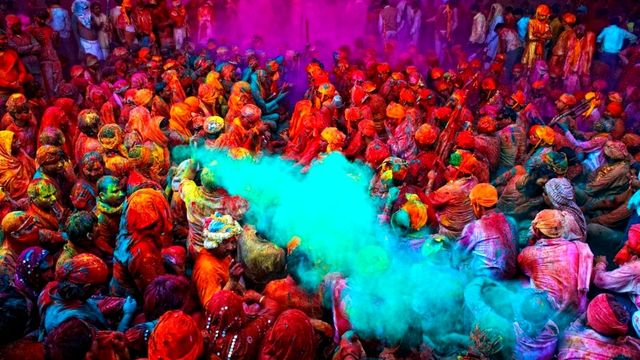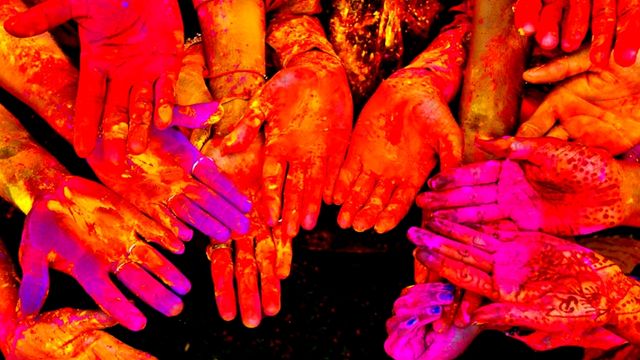Holi, commonly referred to as the “Festival of Colors” or the “Festival of Love,” is a Hindu spring holiday. On the full moon day of the Hindu month of Phalguna, it is observed (usually falling between late February and mid-March).
The celebration is traditionally observed with music, dancing, feasting, and the flinging of colored powders and water. People gather to commemorate the end of winter and the start of spring during this period.
Why Do We Celebrate the Holi Festival?
The celebration of Holi is rooted in many myths and traditions. The tale of Holika, the sister of the demon king Hiranyakashipu, is among the best known. Prahlada, the demon king’s son, allegedly refused to worship him and instead dedicated himself to Lord Vishnu, prompting the demon king to seek to have him killed.
Holika, who possessed a boon making her resistant to fire, made the decision to use her strength to assist her brother. Prahlada was fooled into sitting on her lap, and she later burned herself ablaze. Holika died in the flames, but Lord Vishnu intervened and saved Prahlada. The triumph of good over evil is represented by the tale.

The tale of Radha and Krishna is a fable connected to Holi. The story says that Lord Krishna was angry because Radha had a light complexion and he had a dark one. Yashoda, his mother, advised him to paint Radha’s face and alter her hue to match his own. It is said that this lighthearted action is what started the Holi festival of color-playing.
Individuals of all ages and socioeconomic backgrounds now celebrate Holi. It’s a time for everyone to get along, put the past behind them, and rejoice in the coming of spring. People smear each other with colored powder and water, dance, sing, and enjoy traditional sweets and delicacies. The event stands for harmony, joy, and unity.
How Should We Celebrate the Holi Festival?
Hindus, Sikhs, Jains, and people of other religions all take part in Holi, a well-known and lively festival that is celebrated in India and other places around the world. The “festival of colors,” as it is often known, is typically observed in late February or early March. These are a few ideas for how to observe Holi:
Play with colors: Having fun with colors is the most thrilling element of Holi. It’s a lively and vibrant event where people throw colored powder and water at each other. To safeguard the environment, you can either utilize natural colors or eco-friendly colors.
Wear white: As white highlights the colors more clearly, it is customary to wear white on Holi. Also, you can dress brightly to add to the celebration’s vibrancy.
Make traditional foods: Holi is a time for feasting, so you can make dishes like gujiya, mathri, dahi bhalla, and thandai that are considered to be traditional. Also, you can trade treats and sweets with your loved ones.
Performing music during your celebrations is a crucial component of Holi. You can dance while celebrating the holiday to traditional Holi tunes or any other lively music.
Enjoy Holi with friends and family: You can plan a get-together or a party to celebrate Holi with friends and family. Also, you can pay a visit to your family and friends and exchange sweets and greetings.
Holi is a celebration of love, so take advantage of the opportunity to spread joy and happiness. You can start over with your loved ones and forgive and forget old grudges.
Recall to observe Holi sensibly and abstain from any risky behaviors that can endanger others or harm the environment.

Beyond Colors: Exploring the Unique Celebrations of Holi in India
In India, the popular holiday of Holi is observed in a variety of ways based on the locale, culture, and traditions. Some of the different ways India celebrates Holi include the following:
Lathmar Holi: In Barsana, Uttar Pradesh, women beat males with sticks (lathis) in a playful manner as part of the Lathmar Holi celebration. According to legend, when Lord Krishna went to Barsana, he ridiculed the local women, who then retaliated by chasing him away with sticks. This custom is still practiced today.
Phoolon ki Holi: In Vrindavan, Uttar Pradesh, this version of Holi is observed, where flowers (phool) are used in place of colored powder (gulal). To celebrate the holiday, people fling colored petals at one another.
Rang Panchami: Some places in Madhya Pradesh and Maharashtra celebrate Holi in this way. It is also known as Shimga and is observed five days after the major Holi festival. Colored powder is smeared on each other’s faces, and water balloons and water cannons are thrown.
Dol Purnima: West Bengal, Assam, and Odisha all celebrate this kind of Holi. It heralds the arrival of spring, and people celebrate it by dousing one another with colored powder and water.
Hola Mohalla: The Sikh community in Punjab observes this version of Holi. The three-day celebration features processions, pretend battles, and martial arts.
Khadi Holi: This version of Holi is observed in Uttarakhand’s Kumaon region. People paint each other with natural colors produced from flowers, herbs, and spices while wearing white clothing.
These are just a few of the different ways that India celebrates Holi. The festival is a diverse and vibrant celebration because each type has its own customs and traditions.
For more interesting posts, don’t forget to visit our website, Editorials24 If you find any mistake in our posts, then please tell us by leaving a comment in the comment section given below.